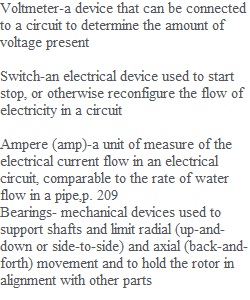


Q Process Technology Equipment Ch. 10 Test Vocabulary Knowledge Voltmeter___ Switch__ Ampere (amp)___ Bearings___ Alternating current (AC)___ Ammeter___ Belt ___ Chains___ Circuit___ Lubricant___ Circuit breaker___ Motor control center (MCC)___ Conductor__ direct current (DC)__ Sprocket__ Couplings__ Electricity___ Ohm___ Electrons ___ Gear___ Generator__ Static electricity___ Gearbox ___ Rectifier___ Sheave___ Transformer___ Watt ___ 1.__electric current that reverses direction periodically, usually 60 times per second. 2.__-device used to measure the electrical current in a circuit. 3.__a unit of measure of the electrical current flow in an electrical circuit,comparable to the rate of water flow in a pipe. 4.__ mechanical devices used to support shafts and limit radial (up-and-down or side-to-side) and axial (back-and-forth) movement and to hold the rotor in alignment with other parts. 5.__a flexible band, placed around two or more pulleys, that transmits rotational energy. 6.__mechanical devices used to transfer rotational energy between two or more sprockets. 7.__a system of electrical components that accomplishes a specific purpose 8.__an electrical component that opens a circuit and stops the flow of electricity when the current reaches unsafe levels. 9.__materials that have electrons that can break free from the flow more easily than the electrons of other materials. 10.__mechanical devices used to connect and transfer rotational energy from the shaft of the driver to the shaft of the driven equipment. 11.__electrical current that flows in a single direction through a conductor. 12.__-the flow of electrons from one point to another along a pathway called a conductor. 13.__-negatively charged particles that orbit the nucleus of an atom. 14.__-a device used to protect equipment and electrical wiring from overcurrent. 15.__-a toothed wheel that engages another toothed mechanism in order to change the speed or direction of transmitted motion. 16.__-mechanical device that houses a set of gears, connects the driver to the load, and allows for changes in speed, torque, and direction. 17.__-a device that converts mechanical energy into electrical energy. 18.__a substance used to reduce friction between two contact surfaces. 19.__an enclosure that houses the equipment for motor control, including its power source, isolation power switches, lockouts, fuses, overload protection devices, ground-fault protection, and sometimes meters for current (amperes) and voltage. 20.__-a measurement of resistance in electrical circuits, p. 21.__a device that converts AC voltage to DC voltage. 22.__-a V-shaped groove centered on the circumference of a wheel, designed to hold a belt, rope, or cable. 23.__ a toothed wheel used in chain drives. 24.__electricity that occurs when a number of electrons build up on the surface of a material but have no positive charge nearby to attract them and cause them to flow. 25.__-an electrical device used to start, stop, or otherwise reconfigure the flow of electricity in a circuit. 26.__an electrical device that takes electricity of one voltage and changes it into another voltage. 27.__the unit used to measure the difference in electrical potential between two points in a circuit. One volt is the force that will cause a current of one amp to flow through a resistance of one ohm. 28.__-a measurement of the potential energy available to push electrons from one point to another. 29.___a device that can be connected to a circuit to determine the amount of voltage present. 30.__a unit of measure of electric power; the power consumed by a current of one amp using an electromotive force of one volt. General Knowledge 1. A rigid coupling is used: a. to allow a motor to accelerate to full speed before the load is increased. b. in applications where small amounts of misalignment can be tolerated. c. to cushion the shock from equipment overloads. d. more frequently in general power transmission service and permits some misalignment. 3. (True or False) One advantage of a chain over a belt driver is that there is no slippage between chain and sprocket teeth. 4.______gears are used to obtain large speed reduc- tions between non intersecting shafts placed at 90-degree angles to one another. a. Spur b. Worm c. Helical d. Bevel 5.___s the spreading of lubricant film into narrow spaces between equipment components. a. Lubrication b. Capillary action C. Corrosion inhibitors d. Antifoams 6. 7. Which of the following are the most important additives used in lubricants? (Select all that apply) a. Corrosion inhibitors b. Antifoams c. Emulsifiers d. Antioxidants 8. Which type of lubricator is used in larger machinery and uses an oil pump to inject lubricant through ducts drilled into rotating members and casings? a. Ring oilers b. Wick feed c. Force feed d. Drip feed 9. (True or False) Interlock systems are designed to prevent rotating equipment from sustaining serious damage when upset conditions or component failures occur. 10. (True or False) Equipment vibration on large rotating equipment can be an indication of a potentially serious problem. 11._______is the process of connecting an object to the earth using copper wire and a rod to provide a path for electricity to dissipate harmlessly into the ground. 12. (True or False) For motors, fast-acting fuses must be used because there is a large current in-rush when a mo- tor starts. 13. What type of bearings are used to prevent axial move- ment of the shaft? a. Roller b. Ball C. Sleeve d. Thrust 14. These are designed to be the “weak link” between the driver, gearbox, or machinery train to prevent seri- ous damage in the event of a malfunction. 15. List four tasks that process technicians might be required to complete to maintain power transmission and lubricating equipment. 16. (True or False) Process technicians perform tasks such as maintaining oil levels, changing system filters, and add- ing grease to bearings. PreviousNext
View Related Questions